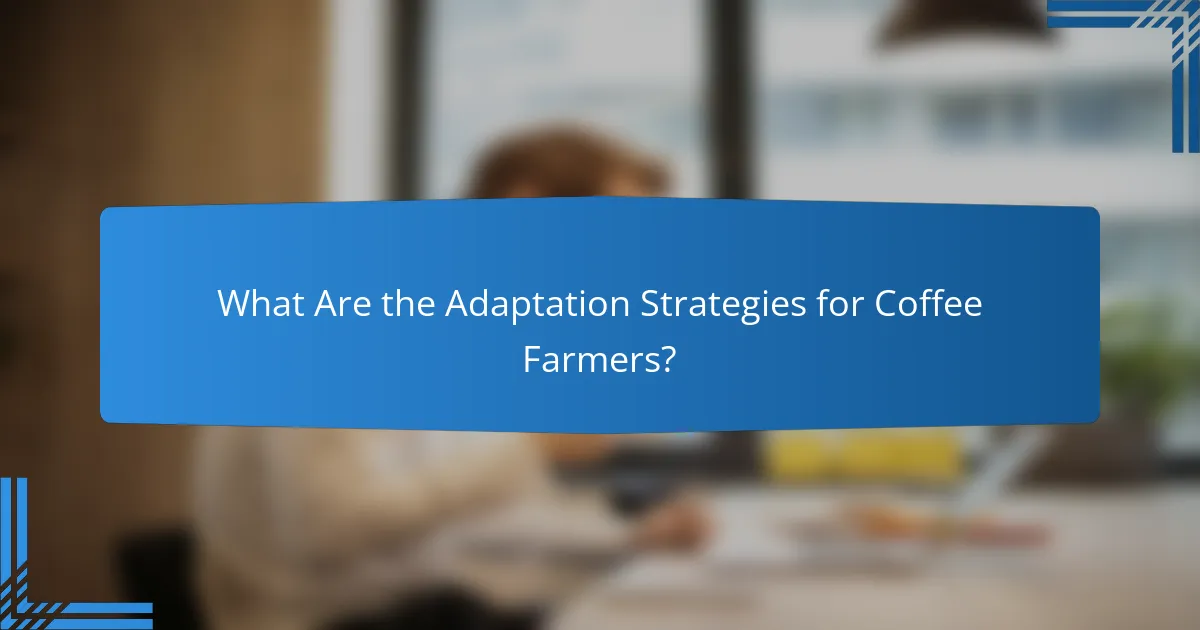Climate change poses a significant threat to specialty coffee production by disrupting the essential growing conditions for coffee plants. Rising temperatures, altered rainfall patterns, and the proliferation of pests and diseases jeopardize both the yield and quality of coffee. As a result, farmers are adopting various adaptation strategies to enhance resilience and sustainability in an increasingly unpredictable environment.

How Does Climate Change Affect Specialty Coffee Production?
Climate change significantly impacts specialty coffee production by altering the conditions necessary for optimal growth. Factors such as temperature increases, changes in rainfall, and the rise of pests and diseases can threaten both yield and quality.
Increased temperatures
Rising temperatures can directly affect coffee plants, which thrive in specific temperature ranges. Optimal growing conditions for specialty coffee are typically between 18°C and 24°C (64°F to 75°F). When temperatures exceed this range, it can lead to reduced yields and affect the flavor profile of the beans.
Farmers may need to adapt their practices, such as adjusting planting times or implementing shade systems to mitigate heat stress on the plants. These adaptations can incur additional costs and require careful management.
Altered rainfall patterns
Climate change leads to unpredictable rainfall patterns, which can result in either droughts or excessive rainfall. Specialty coffee requires a consistent amount of rainfall, ideally between 1,200 mm and 2,500 mm annually, depending on the region.
Farmers may need to invest in irrigation systems or water conservation techniques to cope with these changes. Additionally, irregular rainfall can affect flowering and fruiting cycles, impacting overall production.
Increased pest and disease prevalence
Warmer temperatures and changing climates create favorable conditions for pests and diseases that threaten coffee crops. For instance, the coffee borer beetle and leaf rust disease have become more prevalent in many coffee-growing regions due to climate shifts.
Farmers must adopt integrated pest management strategies and consider resistant coffee varieties to combat these threats. This may involve increased monitoring and potentially higher costs for pest control measures.
Impact on coffee bean quality
Climate change can alter the chemical composition of coffee beans, affecting their flavor and aroma. Beans grown under stress from heat or inconsistent water supply may produce lower quality coffee, which is particularly detrimental for specialty grades that rely on unique flavor profiles.
Maintaining bean quality requires careful attention to growing conditions and post-harvest processing. Farmers may need to invest in better processing facilities or techniques to preserve the quality of their beans.
Changes in growing regions
As climate conditions shift, traditional coffee-growing regions may become unsuitable for cultivation. Areas that once produced high-quality specialty coffee may experience declines in yield or quality, pushing farmers to seek new locations at higher altitudes or different latitudes.
This transition can be challenging, as it involves not only finding suitable land but also adapting to new environmental conditions and potential market changes. Farmers may need support in terms of research and resources to successfully relocate their operations.

What Are the Adaptation Strategies for Coffee Farmers?
Coffee farmers are implementing various adaptation strategies to combat the impacts of climate change on coffee production. These strategies focus on enhancing resilience, improving yields, and ensuring sustainability in the face of changing environmental conditions.
Shade-grown coffee practices
Shade-grown coffee practices involve cultivating coffee plants under a canopy of trees. This method helps regulate temperature and humidity, providing a more stable microclimate for coffee plants. Additionally, shade trees can enhance biodiversity and improve soil health.
Farmers should consider selecting native tree species that are well-suited to their local environment. This not only supports local ecosystems but can also provide additional income through the sale of timber or fruits from the shade trees.
Soil management techniques
Effective soil management techniques are crucial for maintaining soil fertility and structure. Practices such as cover cropping, mulching, and composting can enhance soil organic matter and improve water retention. These methods help mitigate the effects of drought and heavy rainfall.
Farmers should regularly test soil health to determine nutrient needs and adjust their management practices accordingly. Implementing crop rotation can also prevent soil depletion and reduce pest pressures.
Crop diversification
Crop diversification involves growing a variety of crops alongside coffee to reduce risk and increase resilience. By planting different species, farmers can buffer against pests, diseases, and climate variability. This strategy can also provide additional income sources throughout the year.
Farmers might consider integrating fruit trees, legumes, or other cash crops that complement coffee production. This approach not only enhances biodiversity but can also improve soil health and reduce the need for chemical inputs.
Water conservation methods
Water conservation methods are essential for managing water resources effectively, especially in regions facing drought. Techniques such as rainwater harvesting, drip irrigation, and the use of mulch can significantly reduce water usage and improve efficiency.
Farmers should assess their local water availability and implement practices that maximize water retention in the soil. Regular maintenance of irrigation systems is also vital to ensure optimal performance and minimize waste.

What Are the Economic Impacts of Climate Change on Specialty Coffee?
Climate change significantly affects the specialty coffee industry by causing fluctuations in prices, increasing production costs, and creating barriers to market access. These economic impacts ultimately threaten the livelihoods of coffee farmers and the sustainability of coffee production.
Price volatility
Climate change leads to unpredictable weather patterns, which can cause significant price volatility in the specialty coffee market. For instance, droughts or excessive rainfall can reduce crop yields, leading to sudden spikes in prices. Farmers and consumers alike must navigate these fluctuations, which can range from single-digit percentage changes to more dramatic shifts depending on the severity of the weather events.
To mitigate the effects of price volatility, stakeholders can explore options such as futures contracts or price stabilization funds. These tools can help farmers lock in prices and provide some financial predictability amidst the chaos of climate impacts.
Increased production costs
As climate change alters growing conditions, specialty coffee producers face increased production costs. This can stem from the need for more irrigation, pest control, and soil management practices to adapt to changing climates. For example, farmers may need to invest in new technologies or organic treatments to combat pests that thrive in warmer conditions.
Producers should consider diversifying their crops or implementing sustainable practices that can reduce long-term costs. Investing in climate-resilient coffee varieties may also help mitigate some of these rising expenses.
Market access challenges
Climate change can create market access challenges for specialty coffee producers, particularly in regions that are becoming less suitable for coffee cultivation. As traditional growing areas face declining yields, farmers may struggle to meet quality standards required by specialty coffee buyers. This can limit their access to premium markets and reduce their profit margins.
To improve market access, farmers should focus on building relationships with buyers and participating in certification programs that emphasize sustainability. Engaging in cooperatives can also enhance their bargaining power and provide better access to markets.
Impact on farmer livelihoods
The economic impacts of climate change directly threaten the livelihoods of coffee farmers, many of whom depend on coffee as their primary source of income. With rising production costs and price volatility, farmers may find it increasingly difficult to sustain their operations and support their families. This situation can lead to increased poverty levels in coffee-growing communities.
To safeguard their livelihoods, farmers can seek financial assistance through grants or loans aimed at climate adaptation. Additionally, diversifying income sources, such as agro-tourism or alternative crops, can provide a buffer against the economic uncertainties posed by climate change.

How Can Consumers Support Sustainable Coffee Practices?
Consumers can support sustainable coffee practices by making informed choices that prioritize environmental and social responsibility. This includes selecting certified brands, engaging in direct trade, and backing local coffee cooperatives.
Choosing certified brands
Selecting certified brands is a straightforward way to ensure that your coffee is produced sustainably. Look for certifications such as Fair Trade, Rainforest Alliance, or USDA Organic, which indicate adherence to specific environmental and social standards.
These certifications often require producers to follow practices that protect ecosystems and promote fair labor conditions. By choosing certified brands, consumers can help drive demand for sustainable farming methods.
Participating in direct trade
Direct trade involves purchasing coffee directly from farmers, bypassing intermediaries. This approach often results in better prices for growers and fosters closer relationships between consumers and producers.
When participating in direct trade, look for roasters that transparently share their sourcing practices. This not only supports farmers financially but also encourages sustainable agricultural practices as buyers become more invested in the quality and sustainability of the coffee they purchase.
Supporting local coffee cooperatives
Supporting local coffee cooperatives can significantly impact the sustainability of coffee production. These cooperatives often focus on organic farming and fair trade practices, ensuring that profits benefit the community and the environment.
Consider purchasing coffee from cooperatives that emphasize local sourcing and sustainable practices. This not only helps local economies but also promotes biodiversity and reduces the carbon footprint associated with transporting coffee over long distances.
